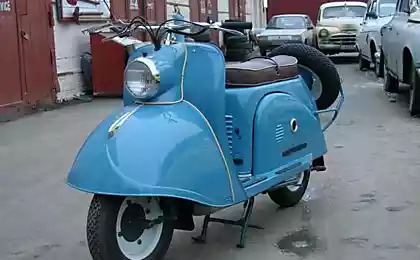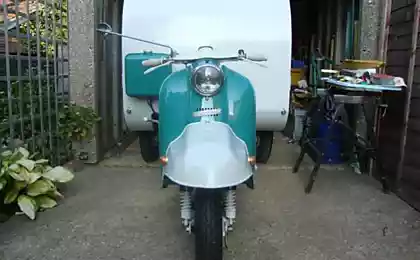671
Ant
The story of the miracle of Soviet technology began in late 1944, when Agostino D'Ascanio - Italian aircraft factory Piaggio has designed an amazing car, soon became known as a scooter.
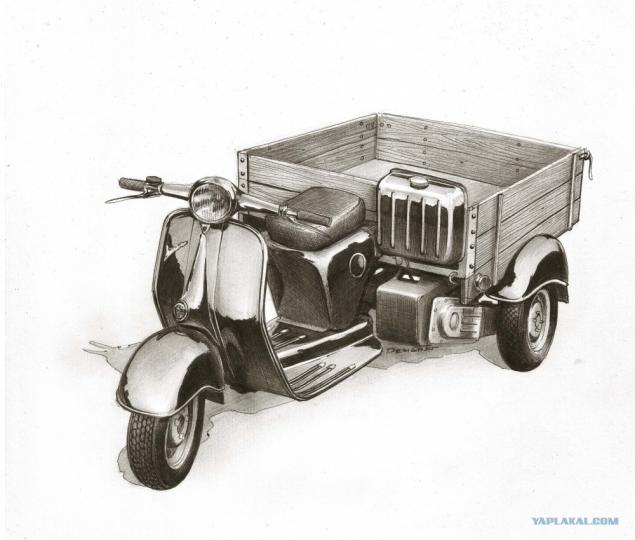
Scooter Agostino D'Ascanio Paperino 1944
However, the term motor scooter was used in our country before the war, but this term prnimat motor scooters, the pioneers who built the stations of young technicians.
Miracle Italian art appeared beautiful, compact, agile and cheap. The creator of a masterpiece is not focused on the basic model and developed a number of its modifications, the best known of whom was onboard three-wheeled truck. Since April 1946 the following such cars Piaggio factory started to mass-produce. but two later, an ode to their production company also took Iso and Innocenti. Their popularity knew no bounds - and the Germans and the Japanese, and even Americans began to imitate the Italians. Some companies made it official by acquiring licenses for the manufacture of vending model. Others, however, counting on impunity, openly copying popular designs. So little by little the developed world motorollerostroenie and the corresponding market, and for decades the world was filled with amazing crew ... Soon outlandish machine interested in the Soviet leadership, and June 19, 1956 the Resolution of the Council of Ministers № 825 on the organization of the production of scooters, and only 7 July Tulmashzavodu enacted before the end of the year to make a 2, 5 thousand. such machines. Factory workers immediately realized the unreality of this task.
When designers showed several foreign scooters, they not only saw them for the first time, but most of them do first learned of their existence. On the question of the minister, what is their opinion, they are, of course, could not give a reasonable answer. However, only a year later, Tula had already been made a pilot batch of scooters, called T-200 Tulitsa. These scooters was a two-stroke engine capacity of 199 cm3 at 62-mm bore and 66-mm piston stroke. With 6, 6 times the compression ratio, the engine gave out 8, 5-strong capacity. The fuel to the engine served gasoline A-72, which cost then the pre-reform 65 cents per liter, in admixture with avtol in the ratio 25: 1.

Tulitsa on which it was designed ant
The engine was equipped with dinastartёrom DS-1A.
This electric machine DC, depending on the mode switching, able to work either as a generator or as a starter, which allows you to run the engine by turning the key in the ignition. Dinastartёr worked in conjunction with the relay regulyatrom PP-121 and 12-volt battery 6MTS-9.
From motor via four-stage gearbox torque is transmitted by means of a chain drive, and on the rear axle differential has been set with a bevel gear and two satellites.
The length of the scooter when the 1830 mm wheelbase was 2690 mm, width - 1250 mm. The height in the version with a van equaled 154 centimeters, while in the version with open body - 1075 mm.
In the same 1957 BC Makhonin designers and IG Lerman based units designed T-200 cargo version in two versions - with a body board TG-200K and van TG-200F. After that was pilot batch of 999 copies. First, "TG" used for internal transport. Transport service of the plant was relieved, because in her possession was just so much light, reliable, nimble and fast cars. In addition to their service and spare parts all was settled quickly. Excess vans transferred to urban services. There, they were very helpful, which contributed to the inclusion of wheel scooter in the plan next year's deliveries to various enterprises of other cities in the country. It has begun serial production of TG-200.
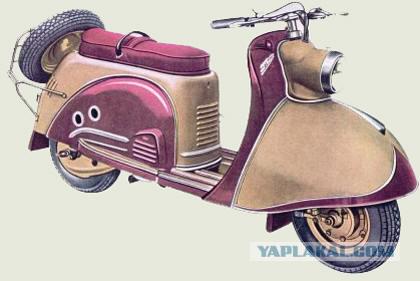
TG-200K
In 1962 he released a series of Tula-wheel scooter with isothermal body for the transport of perishable products, for which designers and Lerman Shchekina awarded medals ENEA. A year later, Tula machines began to exhibit at international exhibitions. They showed great interest, first in Yugoslavia and Germany, and later in other countries. In just 12 years, we made 188 thousand. Wheel scooter types. However, their annual output rose from one to 27 thousand. Copies.
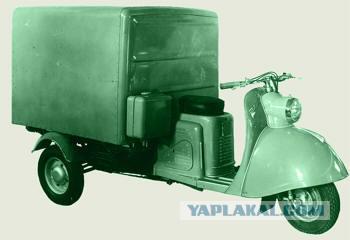
Source:

Scooter Agostino D'Ascanio Paperino 1944
However, the term motor scooter was used in our country before the war, but this term prnimat motor scooters, the pioneers who built the stations of young technicians.
Miracle Italian art appeared beautiful, compact, agile and cheap. The creator of a masterpiece is not focused on the basic model and developed a number of its modifications, the best known of whom was onboard three-wheeled truck. Since April 1946 the following such cars Piaggio factory started to mass-produce. but two later, an ode to their production company also took Iso and Innocenti. Their popularity knew no bounds - and the Germans and the Japanese, and even Americans began to imitate the Italians. Some companies made it official by acquiring licenses for the manufacture of vending model. Others, however, counting on impunity, openly copying popular designs. So little by little the developed world motorollerostroenie and the corresponding market, and for decades the world was filled with amazing crew ... Soon outlandish machine interested in the Soviet leadership, and June 19, 1956 the Resolution of the Council of Ministers № 825 on the organization of the production of scooters, and only 7 July Tulmashzavodu enacted before the end of the year to make a 2, 5 thousand. such machines. Factory workers immediately realized the unreality of this task.
When designers showed several foreign scooters, they not only saw them for the first time, but most of them do first learned of their existence. On the question of the minister, what is their opinion, they are, of course, could not give a reasonable answer. However, only a year later, Tula had already been made a pilot batch of scooters, called T-200 Tulitsa. These scooters was a two-stroke engine capacity of 199 cm3 at 62-mm bore and 66-mm piston stroke. With 6, 6 times the compression ratio, the engine gave out 8, 5-strong capacity. The fuel to the engine served gasoline A-72, which cost then the pre-reform 65 cents per liter, in admixture with avtol in the ratio 25: 1.

Tulitsa on which it was designed ant
The engine was equipped with dinastartёrom DS-1A.
This electric machine DC, depending on the mode switching, able to work either as a generator or as a starter, which allows you to run the engine by turning the key in the ignition. Dinastartёr worked in conjunction with the relay regulyatrom PP-121 and 12-volt battery 6MTS-9.
From motor via four-stage gearbox torque is transmitted by means of a chain drive, and on the rear axle differential has been set with a bevel gear and two satellites.
The length of the scooter when the 1830 mm wheelbase was 2690 mm, width - 1250 mm. The height in the version with a van equaled 154 centimeters, while in the version with open body - 1075 mm.
In the same 1957 BC Makhonin designers and IG Lerman based units designed T-200 cargo version in two versions - with a body board TG-200K and van TG-200F. After that was pilot batch of 999 copies. First, "TG" used for internal transport. Transport service of the plant was relieved, because in her possession was just so much light, reliable, nimble and fast cars. In addition to their service and spare parts all was settled quickly. Excess vans transferred to urban services. There, they were very helpful, which contributed to the inclusion of wheel scooter in the plan next year's deliveries to various enterprises of other cities in the country. It has begun serial production of TG-200.

TG-200K
In 1962 he released a series of Tula-wheel scooter with isothermal body for the transport of perishable products, for which designers and Lerman Shchekina awarded medals ENEA. A year later, Tula machines began to exhibit at international exhibitions. They showed great interest, first in Yugoslavia and Germany, and later in other countries. In just 12 years, we made 188 thousand. Wheel scooter types. However, their annual output rose from one to 27 thousand. Copies.

Source:






